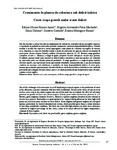Por favor, use este identificador para citar o enlazar este ítem:
http://www.alice.cnptia.embrapa.br/alice/handle/doc/986710Registro completo de metadatos
| Campo DC | Valor | Lengua/Idioma |
|---|---|---|
| dc.contributor.author | RAMOS JUNIOR, E. U. | pt_BR |
| dc.contributor.author | MACHADO, R. A. F. | pt_BR |
| dc.contributor.author | OLIBONE, D. | pt_BR |
| dc.contributor.author | CASTOLDI, G. | pt_BR |
| dc.contributor.author | RAMOS, B. M. | pt_BR |
| dc.date.accessioned | 2014-05-21T11:11:11Z | pt_BR |
| dc.date.available | 2014-05-21T11:11:11Z | pt_BR |
| dc.date.created | 2014-05-21 | pt_BR |
| dc.date.issued | 2013 | pt_BR |
| dc.identifier.citation | Semina: Ciências Agrárias, Londrina, v. 34, n. 1, p. 47-56, jan./fev. 2013. | pt_BR |
| dc.identifier.issn | 1676-546X | pt_BR |
| dc.identifier.uri | http://www.alice.cnptia.embrapa.br/alice/handle/doc/986710 | pt_BR |
| dc.description | RESUMO: Um dos desafios a serem vencidos na implantação do sistema de semeadura direta em regiões tropicais é a produção de palhada na entressafra, período comumente com baixa disponibilidade hídrica. Visando auxiliar a escolha das espécies a serem empregadas como planta de cobertura em regiões de inverno seco, objetivou-se com este trabalho avaliar o efeito de potenciais de água no solo no crescimento de aveia preta (Avena strigosa Sckreb), milheto (Pennisetum glaucum (L.) R. Brown), sorgo granífero (Sorghum bicolor L. Moench.) e sorgo-de-guiné (Sorghum bicolor subespécie bicolor raça guinea). O milheto, mesmo sendo mais sensível ao déficit hídrico, mostrou-se uma boa opção a ser cultivado na entressafra pelo seu elevado potencial produtivo. O sorgo granífero e o sorgo-de-guiné também são boas opções, em especial por terem apresentado abundante sistema radicular, o que possivelmente conferiu aos mesmos certa tolerância a condições de baixa disponibilidade hídrica. A aveia preta, mesmo apresentando aparentemente elevada tolerância à deficiência hídrica (tolerância esta conferida pela maior porcentagem de raízes finas), parece ser muito prejudicada por temperaturas mais elevadas, comuns a estas regiões. ABSTRACT: One of the challenges to be overcome in no till deploying in tropical regions is the production of straw in the offseason, a period commonly with low water availability. To help in the choice of species to be used as cover crop in dry winter regions, the aim of this work was to evaluate the effect of soil water potential on growth of black oat (Avena strigosa Sckreb), pearl millet (Pennisetum glaucum (L.) R. Brown), grain sorghum (Sorghum bicolor L. Moench.) e guinea sorghum(Sorghum bicolor subespécie bicolor raça guinea). Pearl millet is a good option to be cropped during offseason by show high yield potencial, even been more sensitive to water deficit. Grain sorghum and guinea sorghum are also good options, particularly by showed abundant root system, which possibly gives them a certain tolerance to low water availability conditions. The black oat, even with high tolerance to water stress (tolerance conferred by highest percentage of fine roots), seems to be much affected by higher temperatures, common to these regions. | pt_BR |
| dc.language.iso | por | pt_BR |
| dc.rights | openAccess | pt_BR |
| dc.subject | Déficit hídrico | pt_BR |
| dc.title | Crescimento de plantas de cobertura sob déficit hídrico. | pt_BR |
| dc.type | Artigo de periódico | pt_BR |
| dc.date.updated | 2014-05-22T11:11:11Z | pt_BR |
| riaa.ainfo.id | 986710 | pt_BR |
| riaa.ainfo.lastupdate | 2014-05-22 | pt_BR |
| dc.identifier.doi | http://dx.doi.org/10.5433/1679-0359.2013v34n1p47 | pt_BR |
| dc.contributor.institution | EDISON ULISSES RAMOS JUNIOR, CNPSO; ROGÉRIO ALESSANDRO FARIA MACHADO, UFMT; DÁCIO OLIBONE, IFMT; GUSTAVO CASTOLDI, Unesp; BEATRIZ MENEGUCE RAMOS, FACEM. | pt_BR |
| Aparece en las colecciones: | Artigo em periódico indexado (CNPSO)  | |
Ficheros en este ítem:
| Fichero | Descripción | Tamaño | Formato | |
|---|---|---|---|---|
| Crescimentodeplantasdecoberturasobdeficithidrico.pdf | 672,08 kB | Adobe PDF |  Visualizar/Abrir |









